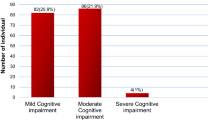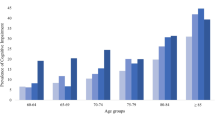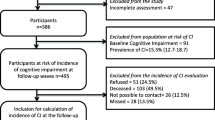Abstract
Aim
To investigate the prevalence of cognitive impairment and its predictors among the elderly in Bangladesh.
Subject and Methods
We use a cross-sectional survey of 1015 older people (≥60 years) in Bangladesh collected jointly by the Sir William Beveridge Foundation (SWBF) and Aging Support Forum (ASF), Bangladesh. The Mini-Mental State Examination (MMSE) scale, adapted to the Bengali language, was used for assessing cognitive impairment, which was available for 111 participants. Logistic regression analysis was used to identify predictors of cognitive impairment. Multiple imputation under the missing-at-random (MAR) mechanism was used to deal with missing data.
Results
Overall, 31 out of 111 (27.9%) participants had mild, moderate or severe cognitive impairment, with a higher proportion among women (33.3%, 17 out of 51) than men (23.3%, 14 out of 60). More precisely, 24 out of 111 (21.6%) and 7 out of 111 (6.3%) had mild/moderate and severe cognitive impairment, respectively, with a higher percentage among women (mild/moderate: 25.5%, severe: 7.8%) than men (mild/moderate: 18.3%, severe: 5.0%). Age (odds ratio, OR = 1.06, p = 0.046, 95% CI: 1.001 to 1.119) and social engagement (OR = 0.25, p = 0.033, 95% CI: 0.072 to 0.898) were found to be statistically significant predictors of cognitive impairment in this group of people. The effect of physical disability fell short of statistical significance at the 5% level but was significant at the 10% level (OR = 2.89, p = 0.099, 90% CI: 0.999 to 8.370).
Conclusion
The prevalence of cognitive impairment in Bangladesh is alarming and is comparatively higher among elderly women, which seems to increase with age and the presence of any physical disability. Also, prevalence appears to be lower in people who are more socially engaged or active.
Similar content being viewed by others
Availability of data and material
All data are available upon request.
Code availability
Not applicable.
References
ADI (2018) World Alzheimer Report: The state of the art of dementia research: New frontiers Alzheimer’s Disease International (ADI). https://www.alz.co.uk/research/WorldAlzheimerReport2018.pdf. Accessed 26 May 2020
Alzheimer’s Society (2020) Mild cognitive impairment (MCI). https://www.alzheimers.org.uk/about-dementia/types-dementia/mild-cognitive-impairment-mci. Accessed 28 May 2020
Barikdar A, Ahmed T, Lasker SP (2016) The Situation of the Elderly in Bangladesh. Bangladesh Journal of Bioethics 7(1):27–36. https://doi.org/10.3329/bioethics.v7i1.29303
Fraser G, Yan R (2007) Guided multiple imputation of missing data: using a subsample to strengthen the missing-at-random assumption. Epidemiology. https://doi.org/10.1097/01.ede.0000254708.40228.8b
Haq A, Sarkar M, Roy S, Alam MF (2017) Dementia among older patients attending National Institute of Mental Health (NIMH), Dhaka, Bangladesh. Bangladesh Journal of Psychiatry 29(1):5–9. https://www.banglajol.info/index.php/bjpsy/article/view/32744
Hugo J, Ganguli M (2014) Dementia and cognitive impairment: epidemiology, diagnosis, and treatment. Clin Geriatr Med 30:421–442. https://doi.org/10.1016/j.cger.2014.04.001
Kabir ZN, Herlitz A (2000) The Bangla Adaptation of Mini-mental State Examination (BAMSE): an instrument to assess cognitive function in illiterate and literate individuals. Int J Geriatr Psychiatry 15(5):441–50
Muqit MM, Ferdous HS (1998) Cognitive impairment in elderly, non-insulin dependent diabetic men in Bangladesh. Bangladesh Med Res Counc Bull 24(2):23–26
Nayan M, Miah M, KMS I (2016) Prevalence of Cognitive Impairment and Functional Status among the Stroke Survivors in Bangladesh. Bangladesh Journal of Occupational Therapy & Rehabilitation 1(1):1–7
Palmer K, Kabir ZN, Ahmed T, Hamadani JD, Cornelius C, Kivipelto M, Wahlin Å (2014) Prevalence of dementia and factors associated with dementia in rural Bangladesh: data from a cross-sectional, population-based study. Int Psychogeriatr 26(11):1905–1915. https://doi.org/10.1017/S1041610214001392
Parry J, Weiyuan C (2011) Looming dementia epidemic in Asia. SciELO Public Health. https://doi.org/10.2471/BLT.11.020311
Prime Minister's Challenge on Dementia (2020) Policy paper. https://www.gov.uk/government/publications/prime-ministers-challenge-on-dementia-2020. Accessed 14 Feb 2021
Rahman M, Tajmim A, Ali M, Sharif M (2017) Overview and Current Status of Alzheimer’s Disease in Bangladesh. J Alzheimer’s Dis Rep 1:27–42. https://doi.org/10.3233/ADR-170012
Royston P (2004) Multiple imputation of missing values. The Stata Journal 4:227–241. https://doi.org/10.1177/1536867X0400400301
Royston P (2005) Multiple imputation of missing values: Update of ice. The Stata Journal 5(4):527–536. https://journals.sagepub.com/doi/pdf/10.1177/1536867X0500500404
Rubin DB (1976) Inference and missing data. Biometrika 63(3):581–592. https://doi.org/10.1093/biomet/63.3.581
Rubin DB (1987) Multiple Imputation for Nonresponse in Surveys. John Wiley & Sons Inc., New York. https://doi.org/10.1002/9780470316696
Sternäng O, Kabir ZN, Hamadani JD, Wahlin Å (2012) A cross-cultural perspective on aging and memory: Comparisons between Bangladesh and Sweden. PsyCh Journal 1:69–81. https://doi.org/10.1002/pchj.14
Sternäng O, Palmer K, Kabir ZN, Hasan MI, Wahlin Å (2019) Associations between functional biological age and cognition among older adults in rural Bangladesh: comparisons with chronological age. Journal of Aging and Health 31:814–836. https://doi.org/10.1177/0898264318757147
Sultana N (2019) The Journey of Alzheimer’s Disease Diagnosis in Bangladesh and Current Perspective. EC Neurology 11(6):390–393. https://www.ecronicon.com/ecne/pdf/ECNE-11-00510.pdf
Uddin MS, Mamun AA, Takeda S, Sarwar MS, Begum MM (2018) Analyzing the chance of developing dementia among geriatric people: a cross-sectional pilot study in Bangladesh. Psychogeriatrics. https://doi.org/10.1111/psyg.12368
White IR, Royston P, Wood AM (2010) Multiple imputation using chained equations: issues and guidance for practice. Statistics in Medicine. https://doi.org/10.1002/sim.4067
WHO (2017) WHO Global Dementia Observatory Provisional Country Profile 2017. https://www.who.int/docs/default-source/mental-health/dementia/gdo-country-profiles/gdo-bangladesh.pdf?sfvrsn=31ea6f39_6&ua=1. Accessed 26 May 2020
WHO (2018) Bangladesh: Alzeimers & Dementia. https://www.worldlifeexpectancy.com/bangladesh-alzheimers-dementia. Accessed 11 Apr 2021
WHO (2019) Dementia. https://www.who.int/news-room/fact-sheets/detail/dementia. Accessed 26 May 2020
WHO (2020) Dementia. https://www.who.int/news-room/fact-sheets/detail/dementia. Accessed 4 Feb 2021
Willacy H (2017) Mini mental state examination (MMSE). https://patient.info/doctor/mini-mental-state-examination-mmse. Accessed 5 Oct 2019
Acknowledgements
The authors would like to acknowledge the Sir William Beveridge Foundation (SWBF) and Aging Support Forum (ASF), Bangladesh, for conducting this survey and providing access to their data.
Funding
The authors received no specific funding for this work.
Author information
Authors and Affiliations
Contributions
ZH and MK conceptualized and designed the study; JKD, NFF and HA were involved with conducting the survey and also contributed to the data collection and management; ZH wrote the draft manuscript; ZH and MK analyzed the data; MK provided critical comments on important intellectual content and jointly contributed in revising the manuscript with ZH. All authors approved the final version of manuscript.
Corresponding author
Ethics declarations
Ethics approval
The study protocol was approved by the ethics committee of the Sir William Beveridge Foundation (SWBF) and Aging Support Forum (ASF), Bangladesh.
Consent to participate
All participants gave informed consent before taking part in the survey.
Consent for publication
Not applicable.
Conflicts of interest/Competing interests
The authors declare that no conflicts of interest exist.
Additional information
Publisher’s note
Springer Nature remains neutral with regard to jurisdictional claims in published maps and institutional affiliations.
Rights and permissions
About this article
Cite this article
Hossain, Z., Das, J.K., Fahim, N.F. et al. Prevalence and predictors of cognitive impairment among the elderly in Bangladesh. J Public Health (Berl.) 31, 529–537 (2023). https://doi.org/10.1007/s10389-021-01569-z
Received:
Accepted:
Published:
Issue Date:
DOI: https://doi.org/10.1007/s10389-021-01569-z




